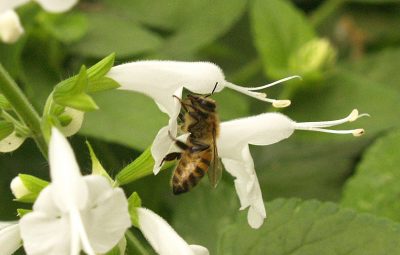Attracting Bees to Your Yard and Garden

Chris Reid
Plant a large diversity of plants and trees
Natives, herbs and heirloom plants are best
Plant things that bloom at different times of the year
Plant a block of bee plants (5-7 plants) as bees are attracted to large groups of flowers
Avoid pesticides to establish beneficial insects in your garden and to prevent harm to pollinators
Leave dead wood and brush piles in the garden area as well as bare land that hasn’t been tilled to provide shelter for brush and ground nesting native bees
Plants that Attract Bees and other Pollinators
Almond Verbena (Aloysia virgata)
Size: up to 15 feet high, 5 feet or more wide
Water requirements: low
Bloom: almond-scented white flowers spring to summer
Light: full sun to part sun
This shrub, native to Argentina, has slightly drooping branches and a flower that will scent the air with a delicious almond fragrance in spring and summer. Almond verbena is mostly evergreen, with fine-textured gray-green foliage. It responds well to light shearing after blooming. The flowers are very attractive to butterflies and bees, as well as passers-by.
Coral vine (Antigonon leptopus)
Size: 6-30 feet long
Water requirements: low to medium
Bloom: intense pink flowers late summer and fall
Light: part sun/part shade
This lovely vine will grow rapidly and will cover other plants and structures, if allowed to. Perfect for patio, fence or garden wall. It attracts bees and butterflies and tolerates poor soil, heat and drought. Dies back to the ground each winter but comes back in the spring. Deciduous. Climbs by tendrils.
Gregg’s Mist Flower (Conoclinium/Eupatorium greggii)
Size: From 12-18″ wide to 12-24″ high
Water requirements: regular watering
Bloom: powdery blue, puffy flowers spring through fall
Light: Sun/part shade
This upright perennial with the pretty blue flowers attracts many different species of butterflies. Moderately fast spreading, it needs to be watered on a regular basis. It is virtually pest and disease free. If you have one, butterflies and other pollinators will visit often.
Huisache/Sweet Acacia (Acacia farnesiana)
Height: 15-25 feet
Width: 10-15 feet
Pretty evergreen to semi-evergreen small tree. Feathery foliage. Bright yellow ball-shaped fragrant flowers cover the tree in early spring. Very durable and adaptable native tree. Very low water requirements.
Light: Full sun (can also take part shade)
Gulf Coast Penstemon (Penstemon tenuis)
Size: 18 inches tall and wide
Water requirements: low
Bloom: pink/purple blooms in the spring
Light: sun or part shade
A Texas native, the Gulf Coast Penstemon (also known as Brazos Penstemon) has dainty pinkish/lavender flowers that the pollinators love. With its showy flower spikes, it provides movement as well as color to the garden design. Cut back after blooms are spent to encourage a fuller shape and more flowering. They will reseed readily.
Flame Acanthus (Anisacanthus quadrifidus wrightii)
Size: grows to 3 feet wide to 3-4 feet tall
Water requirements: drought tolerant but needs moderate water to improve blooming
Bloom: bright orange-red flowers bloom from summer to fall
Light: sun/part shade
This spreading perennial grows to be a small, airy shrub. It produces orange-red tubular flowers that hummingbirds go wild for. It is also a butterfly magnet. Shear back in winter to improve form and flowering. A must-have plant for butterfly gardens!
Kidneywood (Eysenhardtia texana)
Size: 8-15 feet tall, 6-8 feet wide
Water requirements: very low
Bloom: fragrant white flowers spring to fall
Light: sun/part shade
Kidneywood is not only pretty with its airy foliage and deliciously fragrant white flowers, it’s also a favorite of butterflies and other pollinators. If you want to trim it up into more of a traditional tree shape, that’s fine, but it’s also very nice just left to grow on its own. If you have room in your yard for a small, ornamental, easy care tree, try Kidneywood!
Fragrant Mist Flower (Eupatorium havanensis)
Size: from 2-6 feet wide to 2-6 feet tall
Water requirements: drought tolerant, prefers good drainage
Bloom: has fuzzy, fragrant white flowers in the fall
Light: Full sun/part shade
This deciduous medium-sized shrub has a rounded shape and a very nice habit of attracting lots of bees, butterflies and hummingbirds when in bloom. It can take the heat and can even tolerate poorly drained soils, if need be. It will bloom best with sun and a shearing back in the winter.
Anise Hyssop (Agastache foeniculum)
Size: up to 36 inches high, 12 to 24 inches wide
Water requirements: average water needs, good drainage
Bloom: upright spikes of lavender flowers in the summer
Light: Sun to filtered shade
This interesting plant has anise-scented (think licorice!) leaves that can be brewed into a tea. Pollinators like bees, butterflies and hummingbirds flock to Anise Hyssop. It mixes handsomely with other plants and is excellent in borders as well as containers. When there is a mass of plants, the effect of the lavender flowers is showy. Will reseed freely unless blooms have been clipped.
Salvia (Salvia coccinea)
Size: grows from 12″ wide to 18-30″ high
Water requirements: low to average water needs
Bloom: spring through fall
Light: sun to part shade
This is the perfect plant for sunny or shady areas that need a blast of color. This lovely plant wants lots of room. Will reseed freely, ensuring plenty of salvias for next year. Best if used in natural landscapes rather than formal flower beds. Loved by pollinators.
Globe Mallow (Sphaeralcea ambigua)
Size: 2-5 feet tall and wide
Water requirements: low; needs good drainage
Bloom: orange blooms summer to fall
Light: full sun
This lovely plant with the soft leaves and rich, orange blooms is loved by gardeners as well as wildlife. The Globe Mallow also attracts bees and butterflies, which makes it an excellent plant for the garden. Lightly prune for shape in the winter.
categories:
tags:
appeared on episodes:
